Unit6 Keep our city clean (四课时)教案
文档属性
| 名称 | Unit6 Keep our city clean (四课时)教案 | 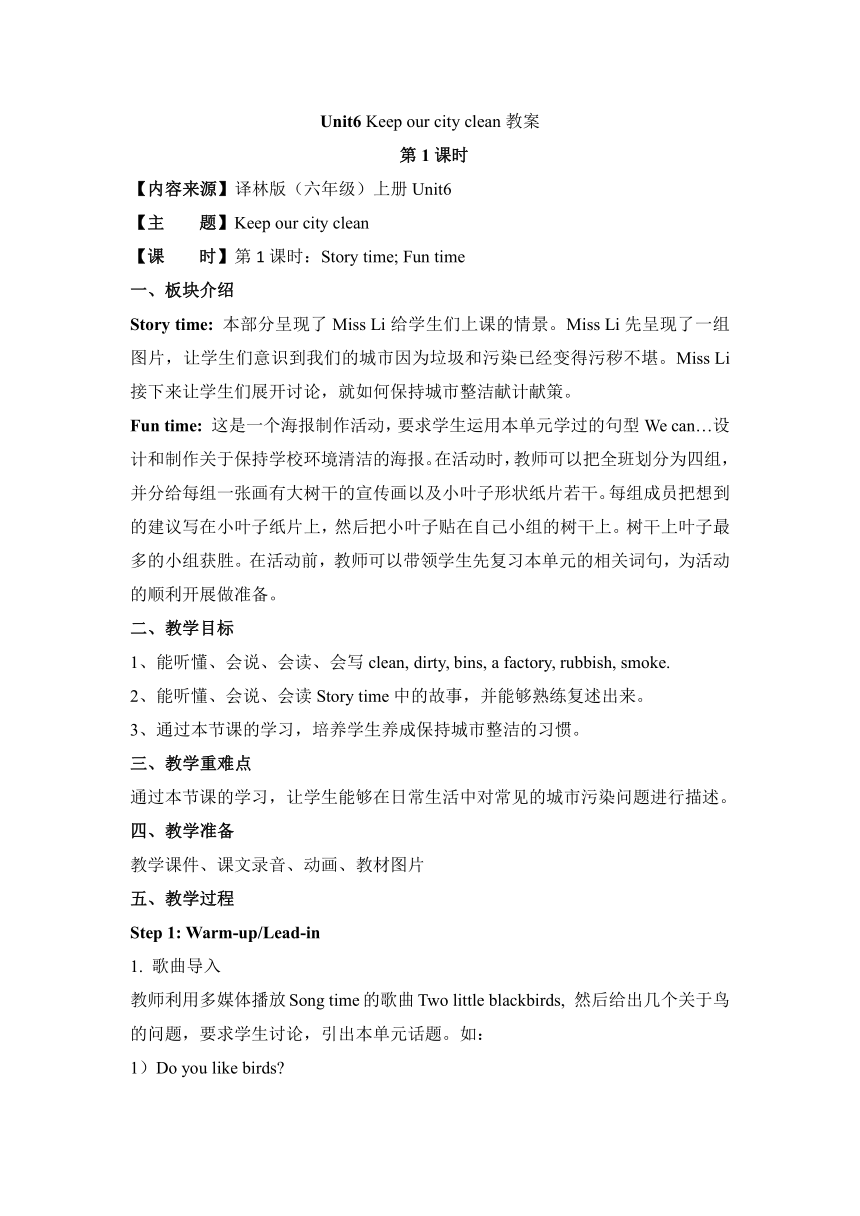 | |
| 格式 | doc | ||
| 文件大小 | 81.5KB | ||
| 资源类型 | 教案 | ||
| 版本资源 | 牛津译林版 | ||
| 科目 | 英语 | ||
| 更新时间 | 2021-08-02 11:55:50 | ||
图片预览

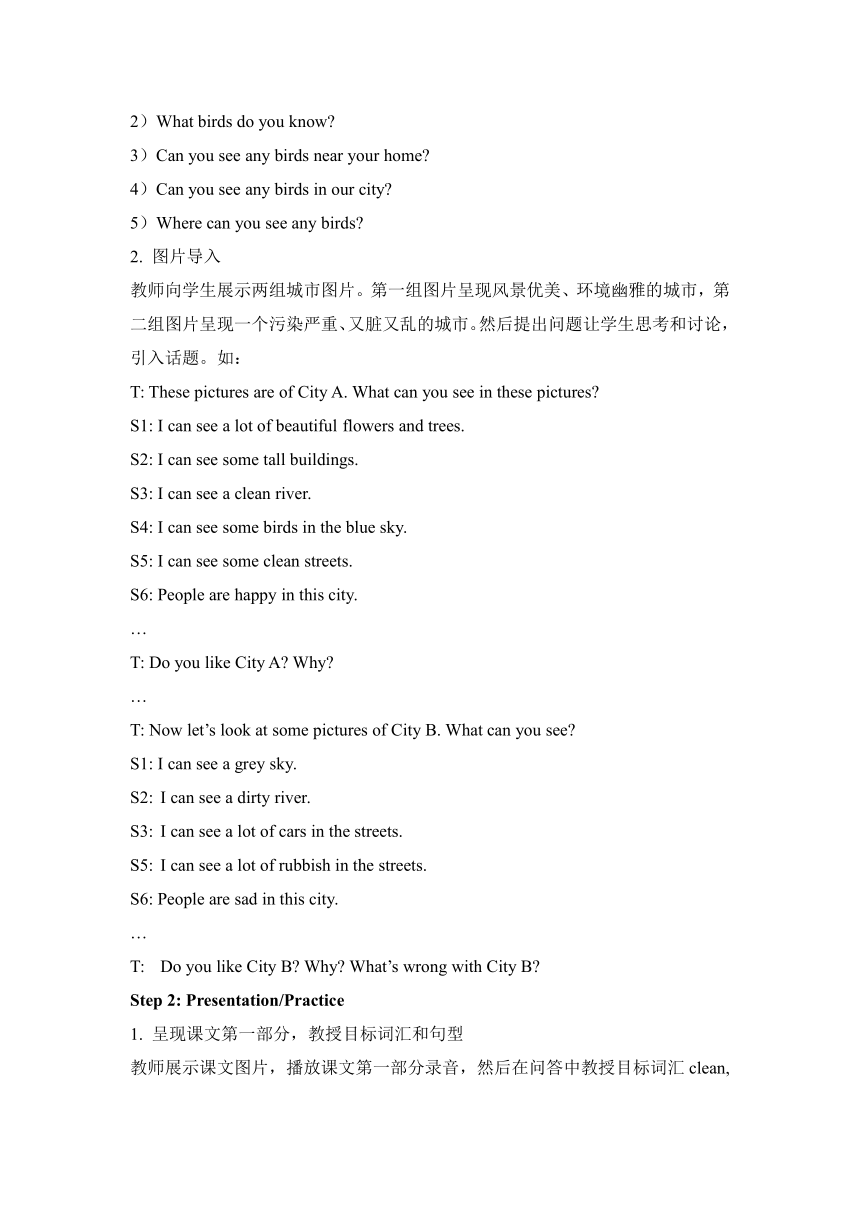
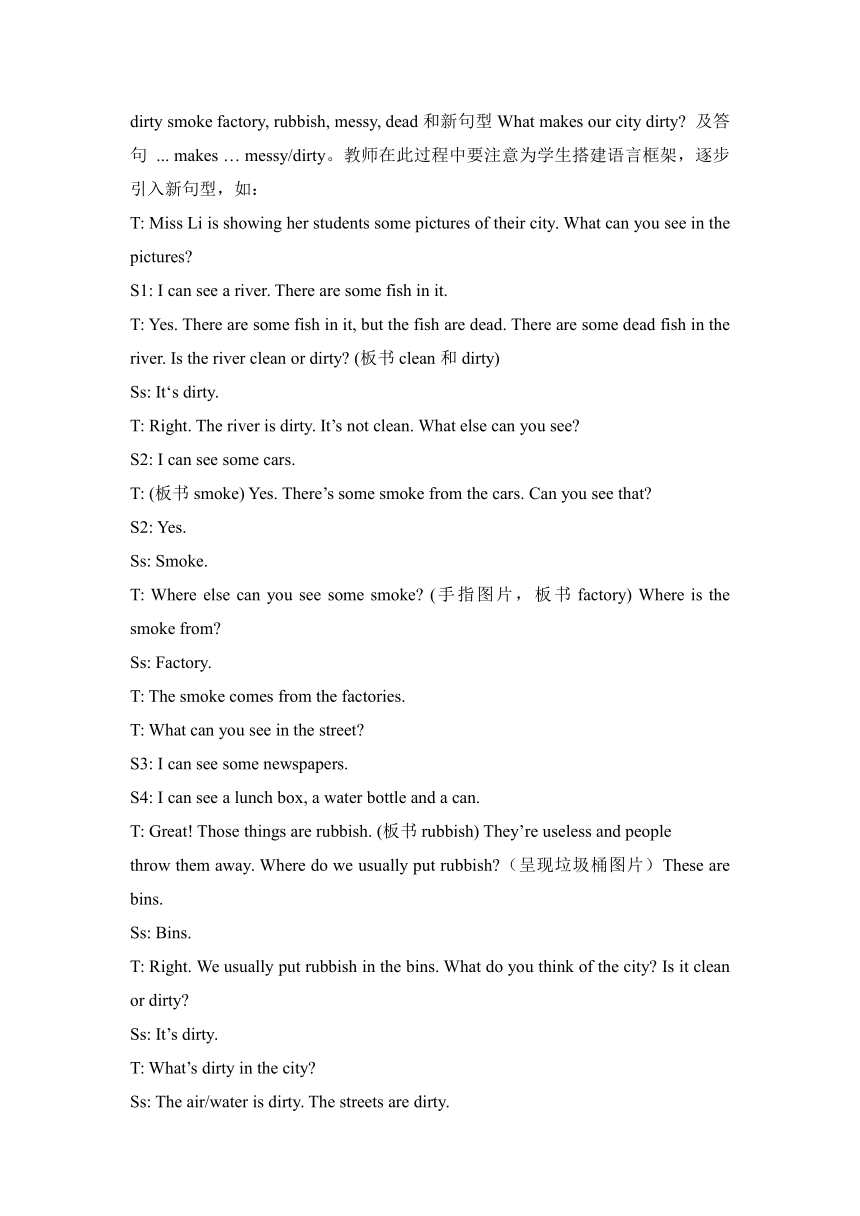
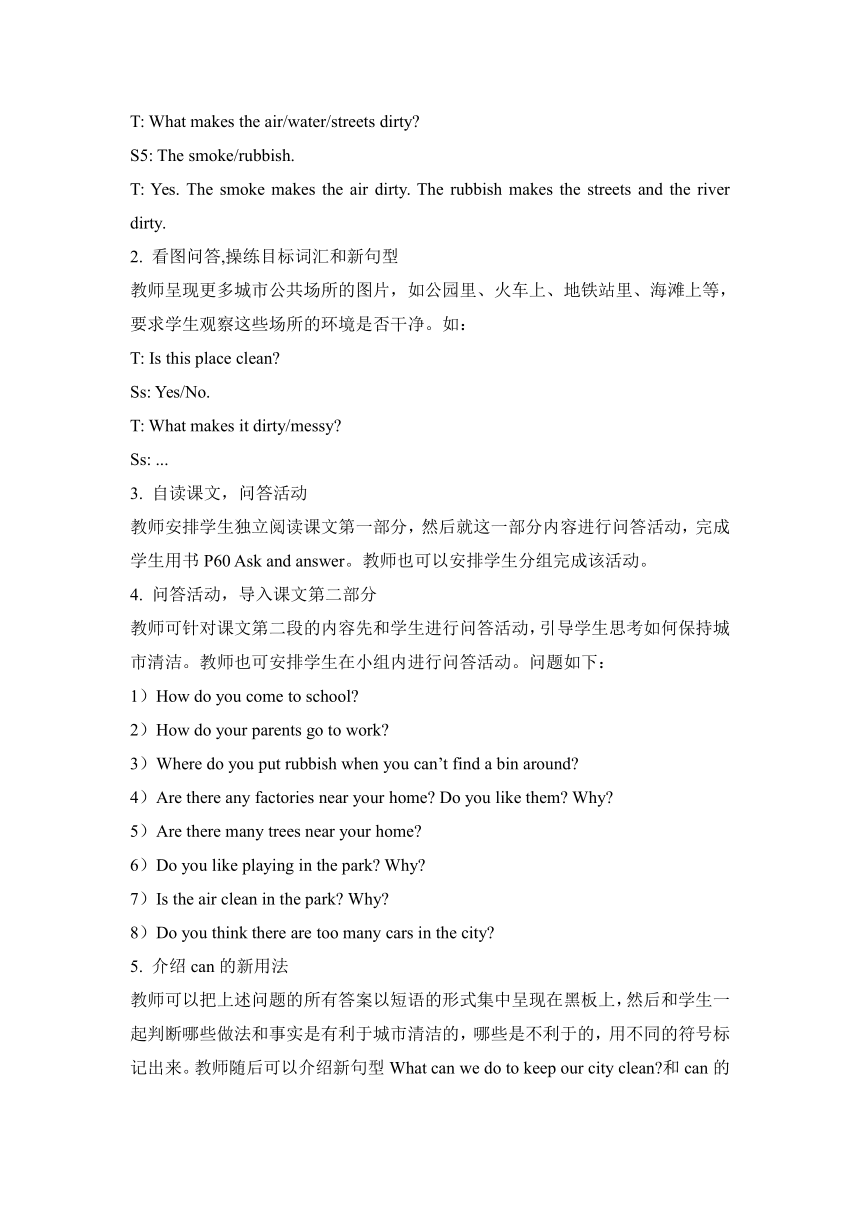
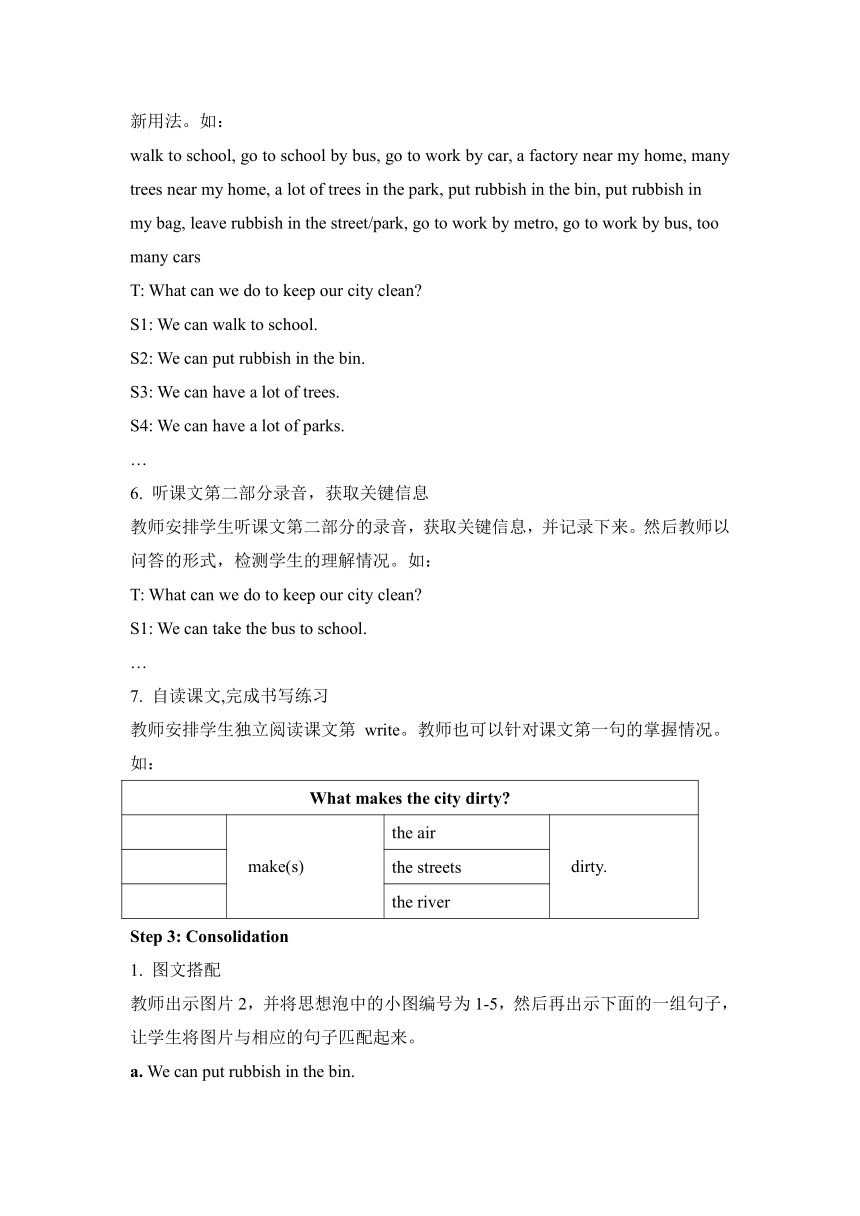
文档简介
Unit6 Keep our city clean教案
第1课时
【内容来源】译林版(六年级)上册Unit6
【主 题】Keep our city clean
【课 时】第1课时:Story time; Fun time
一、板块介绍
Story time: 本部分呈现了Miss Li给学生们上课的情景。Miss Li先呈现了一组图片,让学生们意识到我们的城市因为垃圾和污染已经变得污秽不堪。Miss Li接下来让学生们展开讨论,就如何保持城市整洁献计献策。
Fun time: 这是一个海报制作活动,要求学生运用本单元学过的句型We can…设计和制作关于保持学校环境清洁的海报。在活动时,教师可以把全班划分为四组,并分给每组一张画有大树干的宣传画以及小叶子形状纸片若干。每组成员把想到的建议写在小叶子纸片上,然后把小叶子贴在自己小组的树干上。树干上叶子最多的小组获胜。在活动前,教师可以带领学生先复习本单元的相关词句,为活动的顺利开展做准备。
二、教学目标
1、能听懂、会说、会读、会写clean, dirty, bins, a factory, rubbish, smoke.
2、能听懂、会说、会读Story time中的故事,并能够熟练复述出来。
3、通过本节课的学习,培养学生养成保持城市整洁的习惯。
三、教学重难点
通过本节课的学习,让学生能够在日常生活中对常见的城市污染问题进行描述。
四、教学准备
教学课件、课文录音、动画、教材图片
五、教学过程
Step 1: Warm-up/Lead-in
1. 歌曲导入
教师利用多媒体播放Song time的歌曲Two little blackbirds, 然后给出几个关于鸟的问题,要求学生讨论,引出本单元话题。如:
1)Do you like birds?
2)What birds do you know?
3)Can you see any birds near your home?
4)Can you see any birds in our city?
5)Where can you see any birds?
2. 图片导入
教师向学生展示两组城市图片。第一组图片呈现风景优美、环境幽雅的城市,第二组图片呈现一个污染严重、又脏又乱的城市。然后提出问题让学生思考和讨论,引入话题。如:
T: These pictures are of City A. What can you see in these pictures?
S1: I can see a lot of beautiful flowers and trees.
S2: I can see some tall buildings.
S3: I can see a clean river.
S4: I can see some birds in the blue sky.
S5: I can see some clean streets.
S6: People are happy in this city.
…
T: Do you like City A? Why?
…
T: Now let’s look at some pictures of City B. What can you see?
S1: I can see a grey sky.
S2: I can see a dirty river.
S3: I can see a lot of cars in the streets.
S5: I can see a lot of rubbish in the streets.
S6: People are sad in this city.
…
T: Do you like City B? Why? What’s wrong with City B?
Step 2: Presentation/Practice
1. 呈现课文第一部分,教授目标词汇和句型
教师展示课文图片,播放课文第一部分录音,然后在问答中教授目标词汇clean, dirty smoke factory, rubbish, messy, dead和新句型What makes our city dirty? 及答 句 ... makes … messy/dirty。教师在此过程中要注意为学生搭建语言框架,逐步引入新句型,如:
T: Miss Li is showing her students some pictures of their city. What can you see in the pictures?
S1: I can see a river. There are some fish in it.
T: Yes. There are some fish in it, but the fish are dead. There are some dead fish in the river. Is the river clean or dirty? (板书clean和dirty)
Ss: It‘s dirty.
T: Right. The river is dirty. It’s not clean. What else can you see?
S2: I can see some cars.
T: (板书smoke) Yes. There’s some smoke from the cars. Can you see that?
S2: Yes.
Ss: Smoke.
T: Where else can you see some smoke? (手指图片,板书factory) Where is the smoke from?
Ss: Factory.
T: The smoke comes from the factories.
T: What can you see in the street?
S3: I can see some newspapers.
S4: I can see a lunch box, a water bottle and a can.
T: Great! Those things are rubbish. (板书rubbish) They’re useless and people
throw them away. Where do we usually put rubbish?(呈现垃圾桶图片)These are bins.
Ss: Bins.
T: Right. We usually put rubbish in the bins. What do you think of the city? Is it clean or dirty?
Ss: It’s dirty.
T: What’s dirty in the city?
Ss: The air/water is dirty. The streets are dirty.
T: What makes the air/water/streets dirty?
S5: The smoke/rubbish.
T: Yes. The smoke makes the air dirty. The rubbish makes the streets and the river dirty.
2. 看图问答,操练目标词汇和新句型
教师呈现更多城市公共场所的图片,如公园里、火车上、地铁站里、海滩上等,要求学生观察这些场所的环境是否干净。如:
T: Is this place clean?
Ss: Yes/No.
T: What makes it dirty/messy?
Ss: ...
3. 自读课文,问答活动
教师安排学生独立阅读课文第一部分,然后就这一部分内容进行问答活动,完成 学生用书P60 Ask and answer。教师也可以安排学生分组完成该活动。
4. 问答活动,导入课文第二部分
教师可针对课文第二段的内容先和学生进行问答活动,引导学生思考如何保持城 市清洁。教师也可安排学生在小组内进行问答活动。问题如下:
1)How do you come to school?
2)How do your parents go to work?
3)Where do you put rubbish when you can’t find a bin around?
4)Are there any factories near your home? Do you like them? Why?
5)Are there many trees near your home?
6)Do you like playing in the park? Why?
7)Is the air clean in the park? Why?
8)Do you think there are too many cars in the city?
5. 介绍can的新用法
教师可以把上述问题的所有答案以短语的形式集中呈现在黑板上,然后和学生一 起判断哪些做法和事实是有利于城市清洁的,哪些是不利于的,用不同的符号标 记出来。教师随后可以介绍新句型What can we do to keep our city clean?和can的 新用法。如:
walk to school, go to school by bus, go to work by car, a factory near my home, many trees near my home, a lot of trees in the park, put rubbish in the bin, put rubbish in
my bag, leave rubbish in the street/park, go to work by metro, go to work by bus, too
many cars
T: What can we do to keep our city clean?
S1: We can walk to school.
S2: We can put rubbish in the bin.
S3: We can have a lot of trees.
S4: We can have a lot of parks.
…
6. 听课文第二部分录音,获取关键信息
教师安排学生听课文第二部分的录音,获取关键信息,并记录下来。然后教师以问答的形式,检测学生的理解情况。如:
T: What can we do to keep our city clean?
S1: We can take the bus to school.
…
7. 自读课文,完成书写练习
教师安排学生独立阅读课文第 write。教师也可以针对课文第一句的掌握情况。如:
What makes the city dirty?
make(s) the air
dirty.
the streets
the river
Step 3: Consolidation
1. 图文搭配
教师出示图片2,并将思想泡中的小图编号为1-5,然后再出示下面的一组句子,让学生将图片与相应的句子匹配起来。
a. We can put rubbish in the bin.
b. We can take the bus and the metro to school.
c. We can move some factories away from our city.
d. We can walk to school.
e. We can plant more trees.
2. 问答活动,操练新句型
教师呈现一些城市环境污染的照片,和学生进行问答活动。教师可以先和一名学 生进行示范对话,然后再请同桌学生之间用新句型进行问答活动。如:
T: (出示表现河水很脏的图片) Is the river clean?
S1: No. It’s dirty.
T: What makes the river dirty?
S1: The rubbish makes the river dirty.
T: What can we do to keep the river clean?
S1: We can put the rubbish in the bin.
3. 拓展情境,巩固新句型
教师可以呈现一些不整洁的教室和家居房间的照片,要求学生以小组的形式讨论 教室和房间不整洁的原因,并给出如何保持教室和房间整洁的建议,进一步巩固 和操练两个新句型。
4. 复述课文
教师与个别学生进行问答活动,回顾课文内容,巩固重点词句。如:
T: What makes the city dirty?
S1: ...
T: What can we do to keep the city clean?
S2: ...
教师也可以将学生分成小组,要求他们以接龙的形式回答上述两个问题,完成复述课文的任务。
5. 环保演讲比赛
教师可以组织学生总结城市污染的原因,并提出城市环保方案,写成演讲稿,在班级内展开演讲比赛。教师可以要求学生在演讲时要声情并茂,用眼神与观众交流,从而加强演讲的感染力。如:
Our city is not clean. Some places are even dirty. The air is dirty. The sky is dark and grey. There are no birds in the sky. What makes the air dirty? Smoke from cars makes the air dirty. Smoke from factories makes the air dirty too. The rivers are dirty. There are no fish in the rivers. The rivers smell bad. What makes the rivers dirty? It’s rubbish. Rubbish makes the streets messy and dirty too. We live in this dirty city. We breathe dirty air. We drink dirty water. We walk in the dirty streets. How do you feel? Are you happy?
What can we do to keep our city clean? We can take the bus or walk to school. We can move some factories away from our city centre. We can put rubbish in the bin. We can’t throw rubbish in the river or in the street. We can also plant more trees. Come on, boys and girls! Let’s try our best to keep our city clean!
Fun time:
1. 问答活动,语言准备
T: What can you do to keep our school clean?
S1: I can put rubbish in the bin.
S2: I can pick up the waste paper.
S3: I can clean the classroom.
S4: I can sweep the floor.
S5: I can clean the windows.
S6: I can clean the blackboard.
…
2. 分组制作海报
教师安排学生分组活动,要求每组学生将建议工整清楚地写在小树叶上,然后再统一粘贴在树干上。
3. 海报展示
教师邀请各小组展示自己的海报,并介绍保持学校清洁的建议。
Learning tip
Give a speech on this topic.
就这个话题作一个演讲。
随着学生语言知识的增加和语言技能的提局,教师可以就一些热点话题,组织学生进行演讲比赛,以锻炼学生组织语言和表达大段语言的能力。在演讲前,教师可以为学生提供语言框架,帮助学生构建演讲提纲,也可以提供更多语言材料。 日常交流中,一般疑问句的句末升调并不明显,甚至弱化到平调。教师在教学中不必追求刻意的升调,语调自然即可。
二、教学活动
1. 跟读录音
教师播放歌谣录音,要求学生跟读,并模仿语音语调。
2. 示范朗读
教师可以示范朗读句子,也可以请语音语调较好的学生做示范。教师要提醒学生 边听边体会,边听边模仿。
3. 发现规律
在熟练朗读的基础上,教师可以引导学生发现规律:陈述句句末通常用降调;一般疑问句句末通常用升调。
4. 举一反三
教师呈现更多的陈述句和一般疑问句,要求学生用正确的语调朗读。
5. 朗读比赛
教师组织学生开展朗读比赛,看谁读得准确。
Step 4: Summary
词汇:clean, dirty, bins, a factory, rubbish, smoke.
句型:(1) What makes … dirty/ messy ?
(2)…make(s)…dirty/messy.
(3)---What can we do to …?
---We can …
Step 5: Homework
Pair work: 同学之间两人一组,分角色复述课文Story time.
Ask and answer
参考答案
1. No, it isn’t.
2. Smoke from cars and factories makes the air dirty.
3. Rubbish makes the streets messy and dirty.
4. Yes, it is.
Read and write
参考答案
1. the bus, the metro
2. walk
3. factories
4. rubbish
5. trees
Unit6第2课时
【内容来源】译林版(六年级)上册Unit6
【主 题】Keep our city clean
【课 时】第2课时:Grammar time; Checkout time
一、板块介绍
Grammar time: 本板块归纳了make +名词(宾语)+形容词(补语)的结构和情态动词can(表示可以)的新用法。教师可以设计多种情境和活动帮助学生理解和操练。
Checkout time: 本板块有两个活动。Look and write是看图填空活动,旨在检测学生对课文内容以及对新句型…makes… messy/dirty和We can… 的掌握。在操作本活动时,教师要提醒学生正确使用形容词和动词词组。Look and say是看图说话活动,旨在检测学生对两个重点句型的口头运用能力。教师可以安排学生以小组的形式完成这个口头表达活动。教师也可以根据实际教学需要,把这两个活动和Story time和Grammar time的教学结合起来,达到操练巩固的最佳效果。
二、教学目标
1. 能熟练运用What can we do to …?句型结构。
2. 能够熟练掌握make +名词(宾语)+形容词(补语)的结构和情态动词can(表示可以)的新用法。
三、教学重难点
灵活运用句型What can we do to …?及其答语We can ….
四、教学准备
教学课件
五、教学过程
Step 1: Warm-up/Lead-in
1. 游戏(Jumping tiger)
教师可以利用课件或在黑板呈现一组make +宾语+形容词补语的结构,要求学生
一见到短语,便快速大声读出;若看到跳出的小老虎图片,则拍手。游戏后,教师可引导学生总结规律,理解make一词的用法。教师也可以根据实际情况,拓展介绍
Step 2: Presentation/Practice
句型连连看
keep +宾语+形容词补语的结构。如:
make our city beautiful
make me angry
make the children happy
make her sad
make the street dirty
make the room messy
make the bottle clean
make the child tired
make us excited
make them sleepy
make it long
make it short
make it clear
make the water cold
keep the room clean
keep the room warm keep the children quiet
2. 小组竞赛,操练结构
教师可以给出特定的形容词,让学生四人一组进行习练习,然后各组比赛,看哪个小组给出的词组最多。如:
make ____________________ beautiful
make ____________________ clean
make ____________________ happy
make ____________________ dirty
…
G1: make the room beautiful
make the picture beautiful
make the Christmas tree beautiful
make the card beautiful
make the city beautiful
…
G2: make the desk clean
make the bed clean
make the living room clean
make the city clean
make the river clean
3. 快问快答
教师和学生进行快回快答活动,巩固make ... dirty/clean/beautiful/...结构。如:
T: What makes the air dirty?
Ss: Smoke from factories makes the air dirty.
T: What makes the street dirty?
Ss: Rubbish makes the street dirty.
T: What makes our city beautiful?
Ss: Trees make our city beautiful.
…
4. Magic eyes
教师利用课件随机闪现Plant trees, Put rubbish in the bin, take the bus, take the metro walk to school, pick up the bottles等对环境有利的行为图片和throw rubbish in the river, cut down trees, put rubbish in the river等破坏环境的行为图片。学生看到图片时要大声说出相应的动词短语,并做出相应手势,以判断该行为是否有助于环境保护。如果图片内容是有助于环境保护的,则拍手两下;如果图片内容是破坏环境的,则双手交叉放在胸前。如:
Ss: Take the metro. (拍手两下)
Ss: Throw rubbish into the river. (双手交叉在胸前)
Step 3: Consolidation
接龙游戏,操练情态动词can
教师可以组织学生以小组接龙的方式为保持城市整洁提出自己的建议。教师也可 以要求学生思考如何保持学校、教室、图书馆或者其他公共场所的清洁。如:
S1: What can you do to keep our city clean?
S2: I can take the bus to school. What can you do to keep our city clean?
S3: I can walk to school. What can you do to keep our city clean?
S4: We can move some factories away from our city. What can you do to keep our city clean?
Step 4: Summary
句型:---What makes …?
--- …makes …
make +名词(宾语)+形容词(补语)
Step 5: Homework
情态动词Can的造句(至少5个)。
Look and write
参考答案
1. messy, clothes, toys
2. dirty, messy, put the rubbish
3. dirty, messy, sweep, clean
4. dirty, move some factories
Look and say
参考答案
The dirty clothes make the sofa messy. The rubbish makes the table dirty and messy. The toys, the socks, the books, the crayons and the rubbish make the floor dirty and messy. To keep the room clean, we can put the dirty clothes in a box or a basket. We can put the toys in the box too. We can put the books and the crayons in the schoolbag. We can put the rubbish in the bin. We can also sweep the floor and clean the table.
Unit6第3课时
【内容来源】译林版(六年级)上册Unit6
【主 题】Keep our city clean
【课 时】第3课时:Sound time; Song time
一、板块介绍
Sound time: 本板块呈现了陈述句的降调读法和一般疑问句巨魔升降调的读法。教师要鼓励学生反复朗读,在听、读、模仿中感受英语的语调。严格意义上讲,陈述句句末通常用降调,一般疑问句句末通常用升调。但英美人在现实的日常交流中,一般疑问句的句末升调并不明显,甚至弱化到平调。教师在教学中不必刻意的升调,语调自然即可。
Song time: 这首歌曲讲述了一对鸟儿的故事。两只小鸟Jack和Jill原本栖息在小山上,后因环境污染,双双飞走。多么希望它们能够回来!
二、教学目标
1、能够熟练读出句子的升降调。
2、学唱歌曲Two litter blackbirds.
三、教学重难点
四、教学准备
教学课件,教学音频。
五、教学过程
Step 1: Warm-up/Lead-in
Make a show: 结合上节课的家庭作业,请学生展示自己用Can造的句子。并请学生分小组展示出来,教师并鼓励学生的积极参与。提高学生的团队意思和积极参加班级活动的意识。
Step 2: Presentation/Practice
Sound time:
示范朗读
教师可以示范朗读句子,也可以请语音语调
跟读录音
教师播放录音,要求学生跟读,并模仿语音语调。
发现规律
在熟读的基础上,教师可以引导学生发现规律:陈述句句末通常用降调;一般疑问句句末通常用升调。
举一反三
教师呈现更多的陈述句和一般疑问句,要求学生用正确的语调朗读。
5. 朗读竞赛
教师组织学生开展朗读比赛,看谁读得既准确又有节奏。
Song time:
1. 教师利用课文插图,引入歌曲。如:
T: What can you see?
S1: I can see two birds.
T: Where are they?
S2: They’re sitting on the hill.
2. 伴随节拍,朗读歌词
教师引导学生有节奏地朗读歌词,边朗读边拍手。朗朗上口的歌谣总是能激发学 生的学习兴趣。
3. 播放录音,学生跟唱
教师播放歌曲录音,让学生跟唱。
4. 齐唱歌曲
教师要求学生伴随歌曲录音,齐唱歌曲。
5. 改编歌曲
教师鼓励学生围绕本单元主题“城市环保”改编歌词,创编歌曲。如:
Two little blackbirds living in the city,
One named Jack and one named Kitty.
Too many cars, too much smoke.
Fly away Jack, fly away Kitty.
Come back Jack, come back Kitty.
No more cars, no more smoke.
Step 3: Summary
正确朗读Sound time.
Step 4: Homework
学唱歌曲Two little blackbirds.
Unit6第4课时
【内容来源】译林版(六年级)上册Unit6
【主 题】Keep our city clean
【课 时】第4课时:Cartoon time
一、板块介绍
本板块讲述了在放学途中,Bobby一边和Tina谈论自己喜欢城市生活的理由,一边却乱丢香蕉皮破坏城市环境,导致后面Billy滑了一跤。不过,Bobby最后认识到了自己的错误。教师可以利用这个故事引导学生意识到保护环境要从自己做起,从小事做起。
二、教学目标
1、能够听说读写词汇及词组:museum, throw, skin, ground, pick … up, slip, fall.
2、熟练掌握句型:I like ….
三、教学重难点
能够看图片复述Cartoon time故事内容。
四、教学准备
教学课件
五、教学过程
Step 1: Warm-up/Lead-in
看图问答,预测故事情节
教师呈现四幅图片,要求学生观察并思考问题,预测故事情节。如:
1)Where are Bobby and Tina? (They’re in the street.)
2)What does Bobby do? (He throws a banana skin on the ground.)
3)What happens to Billy? (He slips and falls.)
4)What should Bobby do? (He should put the rubbish in the bin.)
Step 2: Presentation/Practice
听录音,写关键词
教师安排学生听故事的第一部分,然后填空。如:
Bobby likes living in the city because there are many_______, ______and________
Tina likes living in the city because it’s__________ and___________.
听录音,理解故事大意
教师安排学生听故事的第二、三、四部分,回答问题,并适时讲解词汇和词组throw, banana skin, on the ground, slip on, fall等。
1)What does Bobby do after eating a banana?
(He throws the banana skin on the ground.)
2)What happens next?
(Billy slips on the banana skin and falls.)
3)Does Bobby feel sorry?
(Yes, he does.)
3. 自读故事,思考问题
教师安排学生自己阅读故事,然后要求他们用You can/should/shouldn’t…句型给 Bobby提出建议。
跟读对话
教师播放录音,要求学生跟读模仿,注意语音语调。
角色扮演
教师安排学生四人一组,表演故事。表演时要注意语调、动作和表情。
Step 3: Consolidation
我是小小演说家:请学生准备10分钟左右,朗读课文Cartoon time. 在学生准备好之后,教师请学生积极踊跃参加并将Cartoon time课文复述出来。并注意学生的语音语调。教师并鼓励学生积极大胆参加集体活动,从而培养学生的集体荣誉感。教师并和班委一起评选出最佳演说家。
Step 4: Summary
词汇:skin,ground, pick…up, slip, fall.
句型:(1)I like …
(2)You should …
(3)You shouldn’t …
Step 5: Homework
Role play: 分角色表演课文Cartoon time.
第1课时
【内容来源】译林版(六年级)上册Unit6
【主 题】Keep our city clean
【课 时】第1课时:Story time; Fun time
一、板块介绍
Story time: 本部分呈现了Miss Li给学生们上课的情景。Miss Li先呈现了一组图片,让学生们意识到我们的城市因为垃圾和污染已经变得污秽不堪。Miss Li接下来让学生们展开讨论,就如何保持城市整洁献计献策。
Fun time: 这是一个海报制作活动,要求学生运用本单元学过的句型We can…设计和制作关于保持学校环境清洁的海报。在活动时,教师可以把全班划分为四组,并分给每组一张画有大树干的宣传画以及小叶子形状纸片若干。每组成员把想到的建议写在小叶子纸片上,然后把小叶子贴在自己小组的树干上。树干上叶子最多的小组获胜。在活动前,教师可以带领学生先复习本单元的相关词句,为活动的顺利开展做准备。
二、教学目标
1、能听懂、会说、会读、会写clean, dirty, bins, a factory, rubbish, smoke.
2、能听懂、会说、会读Story time中的故事,并能够熟练复述出来。
3、通过本节课的学习,培养学生养成保持城市整洁的习惯。
三、教学重难点
通过本节课的学习,让学生能够在日常生活中对常见的城市污染问题进行描述。
四、教学准备
教学课件、课文录音、动画、教材图片
五、教学过程
Step 1: Warm-up/Lead-in
1. 歌曲导入
教师利用多媒体播放Song time的歌曲Two little blackbirds, 然后给出几个关于鸟的问题,要求学生讨论,引出本单元话题。如:
1)Do you like birds?
2)What birds do you know?
3)Can you see any birds near your home?
4)Can you see any birds in our city?
5)Where can you see any birds?
2. 图片导入
教师向学生展示两组城市图片。第一组图片呈现风景优美、环境幽雅的城市,第二组图片呈现一个污染严重、又脏又乱的城市。然后提出问题让学生思考和讨论,引入话题。如:
T: These pictures are of City A. What can you see in these pictures?
S1: I can see a lot of beautiful flowers and trees.
S2: I can see some tall buildings.
S3: I can see a clean river.
S4: I can see some birds in the blue sky.
S5: I can see some clean streets.
S6: People are happy in this city.
…
T: Do you like City A? Why?
…
T: Now let’s look at some pictures of City B. What can you see?
S1: I can see a grey sky.
S2: I can see a dirty river.
S3: I can see a lot of cars in the streets.
S5: I can see a lot of rubbish in the streets.
S6: People are sad in this city.
…
T: Do you like City B? Why? What’s wrong with City B?
Step 2: Presentation/Practice
1. 呈现课文第一部分,教授目标词汇和句型
教师展示课文图片,播放课文第一部分录音,然后在问答中教授目标词汇clean, dirty smoke factory, rubbish, messy, dead和新句型What makes our city dirty? 及答 句 ... makes … messy/dirty。教师在此过程中要注意为学生搭建语言框架,逐步引入新句型,如:
T: Miss Li is showing her students some pictures of their city. What can you see in the pictures?
S1: I can see a river. There are some fish in it.
T: Yes. There are some fish in it, but the fish are dead. There are some dead fish in the river. Is the river clean or dirty? (板书clean和dirty)
Ss: It‘s dirty.
T: Right. The river is dirty. It’s not clean. What else can you see?
S2: I can see some cars.
T: (板书smoke) Yes. There’s some smoke from the cars. Can you see that?
S2: Yes.
Ss: Smoke.
T: Where else can you see some smoke? (手指图片,板书factory) Where is the smoke from?
Ss: Factory.
T: The smoke comes from the factories.
T: What can you see in the street?
S3: I can see some newspapers.
S4: I can see a lunch box, a water bottle and a can.
T: Great! Those things are rubbish. (板书rubbish) They’re useless and people
throw them away. Where do we usually put rubbish?(呈现垃圾桶图片)These are bins.
Ss: Bins.
T: Right. We usually put rubbish in the bins. What do you think of the city? Is it clean or dirty?
Ss: It’s dirty.
T: What’s dirty in the city?
Ss: The air/water is dirty. The streets are dirty.
T: What makes the air/water/streets dirty?
S5: The smoke/rubbish.
T: Yes. The smoke makes the air dirty. The rubbish makes the streets and the river dirty.
2. 看图问答,操练目标词汇和新句型
教师呈现更多城市公共场所的图片,如公园里、火车上、地铁站里、海滩上等,要求学生观察这些场所的环境是否干净。如:
T: Is this place clean?
Ss: Yes/No.
T: What makes it dirty/messy?
Ss: ...
3. 自读课文,问答活动
教师安排学生独立阅读课文第一部分,然后就这一部分内容进行问答活动,完成 学生用书P60 Ask and answer。教师也可以安排学生分组完成该活动。
4. 问答活动,导入课文第二部分
教师可针对课文第二段的内容先和学生进行问答活动,引导学生思考如何保持城 市清洁。教师也可安排学生在小组内进行问答活动。问题如下:
1)How do you come to school?
2)How do your parents go to work?
3)Where do you put rubbish when you can’t find a bin around?
4)Are there any factories near your home? Do you like them? Why?
5)Are there many trees near your home?
6)Do you like playing in the park? Why?
7)Is the air clean in the park? Why?
8)Do you think there are too many cars in the city?
5. 介绍can的新用法
教师可以把上述问题的所有答案以短语的形式集中呈现在黑板上,然后和学生一 起判断哪些做法和事实是有利于城市清洁的,哪些是不利于的,用不同的符号标 记出来。教师随后可以介绍新句型What can we do to keep our city clean?和can的 新用法。如:
walk to school, go to school by bus, go to work by car, a factory near my home, many trees near my home, a lot of trees in the park, put rubbish in the bin, put rubbish in
my bag, leave rubbish in the street/park, go to work by metro, go to work by bus, too
many cars
T: What can we do to keep our city clean?
S1: We can walk to school.
S2: We can put rubbish in the bin.
S3: We can have a lot of trees.
S4: We can have a lot of parks.
…
6. 听课文第二部分录音,获取关键信息
教师安排学生听课文第二部分的录音,获取关键信息,并记录下来。然后教师以问答的形式,检测学生的理解情况。如:
T: What can we do to keep our city clean?
S1: We can take the bus to school.
…
7. 自读课文,完成书写练习
教师安排学生独立阅读课文第 write。教师也可以针对课文第一句的掌握情况。如:
What makes the city dirty?
make(s) the air
dirty.
the streets
the river
Step 3: Consolidation
1. 图文搭配
教师出示图片2,并将思想泡中的小图编号为1-5,然后再出示下面的一组句子,让学生将图片与相应的句子匹配起来。
a. We can put rubbish in the bin.
b. We can take the bus and the metro to school.
c. We can move some factories away from our city.
d. We can walk to school.
e. We can plant more trees.
2. 问答活动,操练新句型
教师呈现一些城市环境污染的照片,和学生进行问答活动。教师可以先和一名学 生进行示范对话,然后再请同桌学生之间用新句型进行问答活动。如:
T: (出示表现河水很脏的图片) Is the river clean?
S1: No. It’s dirty.
T: What makes the river dirty?
S1: The rubbish makes the river dirty.
T: What can we do to keep the river clean?
S1: We can put the rubbish in the bin.
3. 拓展情境,巩固新句型
教师可以呈现一些不整洁的教室和家居房间的照片,要求学生以小组的形式讨论 教室和房间不整洁的原因,并给出如何保持教室和房间整洁的建议,进一步巩固 和操练两个新句型。
4. 复述课文
教师与个别学生进行问答活动,回顾课文内容,巩固重点词句。如:
T: What makes the city dirty?
S1: ...
T: What can we do to keep the city clean?
S2: ...
教师也可以将学生分成小组,要求他们以接龙的形式回答上述两个问题,完成复述课文的任务。
5. 环保演讲比赛
教师可以组织学生总结城市污染的原因,并提出城市环保方案,写成演讲稿,在班级内展开演讲比赛。教师可以要求学生在演讲时要声情并茂,用眼神与观众交流,从而加强演讲的感染力。如:
Our city is not clean. Some places are even dirty. The air is dirty. The sky is dark and grey. There are no birds in the sky. What makes the air dirty? Smoke from cars makes the air dirty. Smoke from factories makes the air dirty too. The rivers are dirty. There are no fish in the rivers. The rivers smell bad. What makes the rivers dirty? It’s rubbish. Rubbish makes the streets messy and dirty too. We live in this dirty city. We breathe dirty air. We drink dirty water. We walk in the dirty streets. How do you feel? Are you happy?
What can we do to keep our city clean? We can take the bus or walk to school. We can move some factories away from our city centre. We can put rubbish in the bin. We can’t throw rubbish in the river or in the street. We can also plant more trees. Come on, boys and girls! Let’s try our best to keep our city clean!
Fun time:
1. 问答活动,语言准备
T: What can you do to keep our school clean?
S1: I can put rubbish in the bin.
S2: I can pick up the waste paper.
S3: I can clean the classroom.
S4: I can sweep the floor.
S5: I can clean the windows.
S6: I can clean the blackboard.
…
2. 分组制作海报
教师安排学生分组活动,要求每组学生将建议工整清楚地写在小树叶上,然后再统一粘贴在树干上。
3. 海报展示
教师邀请各小组展示自己的海报,并介绍保持学校清洁的建议。
Learning tip
Give a speech on this topic.
就这个话题作一个演讲。
随着学生语言知识的增加和语言技能的提局,教师可以就一些热点话题,组织学生进行演讲比赛,以锻炼学生组织语言和表达大段语言的能力。在演讲前,教师可以为学生提供语言框架,帮助学生构建演讲提纲,也可以提供更多语言材料。 日常交流中,一般疑问句的句末升调并不明显,甚至弱化到平调。教师在教学中不必追求刻意的升调,语调自然即可。
二、教学活动
1. 跟读录音
教师播放歌谣录音,要求学生跟读,并模仿语音语调。
2. 示范朗读
教师可以示范朗读句子,也可以请语音语调较好的学生做示范。教师要提醒学生 边听边体会,边听边模仿。
3. 发现规律
在熟练朗读的基础上,教师可以引导学生发现规律:陈述句句末通常用降调;一般疑问句句末通常用升调。
4. 举一反三
教师呈现更多的陈述句和一般疑问句,要求学生用正确的语调朗读。
5. 朗读比赛
教师组织学生开展朗读比赛,看谁读得准确。
Step 4: Summary
词汇:clean, dirty, bins, a factory, rubbish, smoke.
句型:(1) What makes … dirty/ messy ?
(2)…make(s)…dirty/messy.
(3)---What can we do to …?
---We can …
Step 5: Homework
Pair work: 同学之间两人一组,分角色复述课文Story time.
Ask and answer
参考答案
1. No, it isn’t.
2. Smoke from cars and factories makes the air dirty.
3. Rubbish makes the streets messy and dirty.
4. Yes, it is.
Read and write
参考答案
1. the bus, the metro
2. walk
3. factories
4. rubbish
5. trees
Unit6第2课时
【内容来源】译林版(六年级)上册Unit6
【主 题】Keep our city clean
【课 时】第2课时:Grammar time; Checkout time
一、板块介绍
Grammar time: 本板块归纳了make +名词(宾语)+形容词(补语)的结构和情态动词can(表示可以)的新用法。教师可以设计多种情境和活动帮助学生理解和操练。
Checkout time: 本板块有两个活动。Look and write是看图填空活动,旨在检测学生对课文内容以及对新句型…makes… messy/dirty和We can… 的掌握。在操作本活动时,教师要提醒学生正确使用形容词和动词词组。Look and say是看图说话活动,旨在检测学生对两个重点句型的口头运用能力。教师可以安排学生以小组的形式完成这个口头表达活动。教师也可以根据实际教学需要,把这两个活动和Story time和Grammar time的教学结合起来,达到操练巩固的最佳效果。
二、教学目标
1. 能熟练运用What can we do to …?句型结构。
2. 能够熟练掌握make +名词(宾语)+形容词(补语)的结构和情态动词can(表示可以)的新用法。
三、教学重难点
灵活运用句型What can we do to …?及其答语We can ….
四、教学准备
教学课件
五、教学过程
Step 1: Warm-up/Lead-in
1. 游戏(Jumping tiger)
教师可以利用课件或在黑板呈现一组make +宾语+形容词补语的结构,要求学生
一见到短语,便快速大声读出;若看到跳出的小老虎图片,则拍手。游戏后,教师可引导学生总结规律,理解make一词的用法。教师也可以根据实际情况,拓展介绍
Step 2: Presentation/Practice
句型连连看
keep +宾语+形容词补语的结构。如:
make our city beautiful
make me angry
make the children happy
make her sad
make the street dirty
make the room messy
make the bottle clean
make the child tired
make us excited
make them sleepy
make it long
make it short
make it clear
make the water cold
keep the room clean
keep the room warm keep the children quiet
2. 小组竞赛,操练结构
教师可以给出特定的形容词,让学生四人一组进行习练习,然后各组比赛,看哪个小组给出的词组最多。如:
make ____________________ beautiful
make ____________________ clean
make ____________________ happy
make ____________________ dirty
…
G1: make the room beautiful
make the picture beautiful
make the Christmas tree beautiful
make the card beautiful
make the city beautiful
…
G2: make the desk clean
make the bed clean
make the living room clean
make the city clean
make the river clean
3. 快问快答
教师和学生进行快回快答活动,巩固make ... dirty/clean/beautiful/...结构。如:
T: What makes the air dirty?
Ss: Smoke from factories makes the air dirty.
T: What makes the street dirty?
Ss: Rubbish makes the street dirty.
T: What makes our city beautiful?
Ss: Trees make our city beautiful.
…
4. Magic eyes
教师利用课件随机闪现Plant trees, Put rubbish in the bin, take the bus, take the metro walk to school, pick up the bottles等对环境有利的行为图片和throw rubbish in the river, cut down trees, put rubbish in the river等破坏环境的行为图片。学生看到图片时要大声说出相应的动词短语,并做出相应手势,以判断该行为是否有助于环境保护。如果图片内容是有助于环境保护的,则拍手两下;如果图片内容是破坏环境的,则双手交叉放在胸前。如:
Ss: Take the metro. (拍手两下)
Ss: Throw rubbish into the river. (双手交叉在胸前)
Step 3: Consolidation
接龙游戏,操练情态动词can
教师可以组织学生以小组接龙的方式为保持城市整洁提出自己的建议。教师也可 以要求学生思考如何保持学校、教室、图书馆或者其他公共场所的清洁。如:
S1: What can you do to keep our city clean?
S2: I can take the bus to school. What can you do to keep our city clean?
S3: I can walk to school. What can you do to keep our city clean?
S4: We can move some factories away from our city. What can you do to keep our city clean?
Step 4: Summary
句型:---What makes …?
--- …makes …
make +名词(宾语)+形容词(补语)
Step 5: Homework
情态动词Can的造句(至少5个)。
Look and write
参考答案
1. messy, clothes, toys
2. dirty, messy, put the rubbish
3. dirty, messy, sweep, clean
4. dirty, move some factories
Look and say
参考答案
The dirty clothes make the sofa messy. The rubbish makes the table dirty and messy. The toys, the socks, the books, the crayons and the rubbish make the floor dirty and messy. To keep the room clean, we can put the dirty clothes in a box or a basket. We can put the toys in the box too. We can put the books and the crayons in the schoolbag. We can put the rubbish in the bin. We can also sweep the floor and clean the table.
Unit6第3课时
【内容来源】译林版(六年级)上册Unit6
【主 题】Keep our city clean
【课 时】第3课时:Sound time; Song time
一、板块介绍
Sound time: 本板块呈现了陈述句的降调读法和一般疑问句巨魔升降调的读法。教师要鼓励学生反复朗读,在听、读、模仿中感受英语的语调。严格意义上讲,陈述句句末通常用降调,一般疑问句句末通常用升调。但英美人在现实的日常交流中,一般疑问句的句末升调并不明显,甚至弱化到平调。教师在教学中不必刻意的升调,语调自然即可。
Song time: 这首歌曲讲述了一对鸟儿的故事。两只小鸟Jack和Jill原本栖息在小山上,后因环境污染,双双飞走。多么希望它们能够回来!
二、教学目标
1、能够熟练读出句子的升降调。
2、学唱歌曲Two litter blackbirds.
三、教学重难点
四、教学准备
教学课件,教学音频。
五、教学过程
Step 1: Warm-up/Lead-in
Make a show: 结合上节课的家庭作业,请学生展示自己用Can造的句子。并请学生分小组展示出来,教师并鼓励学生的积极参与。提高学生的团队意思和积极参加班级活动的意识。
Step 2: Presentation/Practice
Sound time:
示范朗读
教师可以示范朗读句子,也可以请语音语调
跟读录音
教师播放录音,要求学生跟读,并模仿语音语调。
发现规律
在熟读的基础上,教师可以引导学生发现规律:陈述句句末通常用降调;一般疑问句句末通常用升调。
举一反三
教师呈现更多的陈述句和一般疑问句,要求学生用正确的语调朗读。
5. 朗读竞赛
教师组织学生开展朗读比赛,看谁读得既准确又有节奏。
Song time:
1. 教师利用课文插图,引入歌曲。如:
T: What can you see?
S1: I can see two birds.
T: Where are they?
S2: They’re sitting on the hill.
2. 伴随节拍,朗读歌词
教师引导学生有节奏地朗读歌词,边朗读边拍手。朗朗上口的歌谣总是能激发学 生的学习兴趣。
3. 播放录音,学生跟唱
教师播放歌曲录音,让学生跟唱。
4. 齐唱歌曲
教师要求学生伴随歌曲录音,齐唱歌曲。
5. 改编歌曲
教师鼓励学生围绕本单元主题“城市环保”改编歌词,创编歌曲。如:
Two little blackbirds living in the city,
One named Jack and one named Kitty.
Too many cars, too much smoke.
Fly away Jack, fly away Kitty.
Come back Jack, come back Kitty.
No more cars, no more smoke.
Step 3: Summary
正确朗读Sound time.
Step 4: Homework
学唱歌曲Two little blackbirds.
Unit6第4课时
【内容来源】译林版(六年级)上册Unit6
【主 题】Keep our city clean
【课 时】第4课时:Cartoon time
一、板块介绍
本板块讲述了在放学途中,Bobby一边和Tina谈论自己喜欢城市生活的理由,一边却乱丢香蕉皮破坏城市环境,导致后面Billy滑了一跤。不过,Bobby最后认识到了自己的错误。教师可以利用这个故事引导学生意识到保护环境要从自己做起,从小事做起。
二、教学目标
1、能够听说读写词汇及词组:museum, throw, skin, ground, pick … up, slip, fall.
2、熟练掌握句型:I like ….
三、教学重难点
能够看图片复述Cartoon time故事内容。
四、教学准备
教学课件
五、教学过程
Step 1: Warm-up/Lead-in
看图问答,预测故事情节
教师呈现四幅图片,要求学生观察并思考问题,预测故事情节。如:
1)Where are Bobby and Tina? (They’re in the street.)
2)What does Bobby do? (He throws a banana skin on the ground.)
3)What happens to Billy? (He slips and falls.)
4)What should Bobby do? (He should put the rubbish in the bin.)
Step 2: Presentation/Practice
听录音,写关键词
教师安排学生听故事的第一部分,然后填空。如:
Bobby likes living in the city because there are many_______, ______and________
Tina likes living in the city because it’s__________ and___________.
听录音,理解故事大意
教师安排学生听故事的第二、三、四部分,回答问题,并适时讲解词汇和词组throw, banana skin, on the ground, slip on, fall等。
1)What does Bobby do after eating a banana?
(He throws the banana skin on the ground.)
2)What happens next?
(Billy slips on the banana skin and falls.)
3)Does Bobby feel sorry?
(Yes, he does.)
3. 自读故事,思考问题
教师安排学生自己阅读故事,然后要求他们用You can/should/shouldn’t…句型给 Bobby提出建议。
跟读对话
教师播放录音,要求学生跟读模仿,注意语音语调。
角色扮演
教师安排学生四人一组,表演故事。表演时要注意语调、动作和表情。
Step 3: Consolidation
我是小小演说家:请学生准备10分钟左右,朗读课文Cartoon time. 在学生准备好之后,教师请学生积极踊跃参加并将Cartoon time课文复述出来。并注意学生的语音语调。教师并鼓励学生积极大胆参加集体活动,从而培养学生的集体荣誉感。教师并和班委一起评选出最佳演说家。
Step 4: Summary
词汇:skin,ground, pick…up, slip, fall.
句型:(1)I like …
(2)You should …
(3)You shouldn’t …
Step 5: Homework
Role play: 分角色表演课文Cartoon time.
